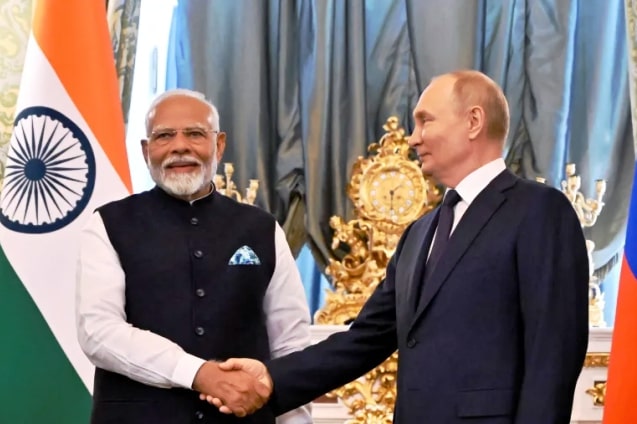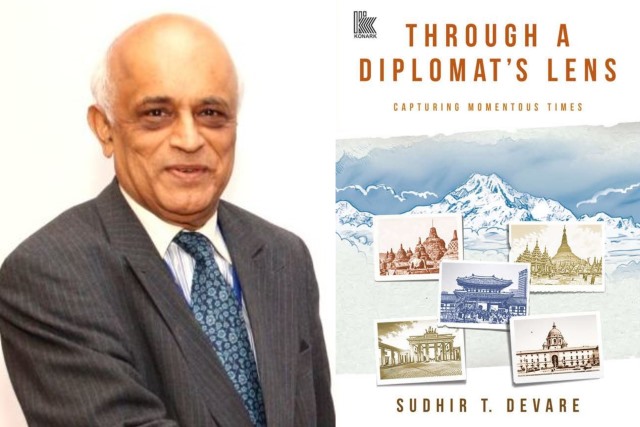
So, What Took Modi To Moscow!
On February 24, 2022, the day Russia invaded Ukraine, the then-Pakistan Prime Minister Imran Khan was in Moscow on a pre-planned visit. That was the beginning of the end of his being in power – at least he thinks so.
Neither India nor Prime Minister Narendra Modi is in the same league with Vladimir Putin and Russia. But India’s Western allies are livid about Modi’s visit, planned long ago and part of the annual India-Russia summit.
Modi was in Moscow on a day Russia bombarded a school in Ukraine killing children, a sore point with the West that, otherwise, is either unwilling, unable or both to restrain Israel from doing the same in Gaza, another conflict zone. But the two wrongs, whether accepted as such or not, do not make one right.
Western critics are asking why Modi chose to go to Moscow and hug Putin, so soon after the latter had embraced North Korean leader Kim Jong Un, another leader the West intensely dislikes. At home, the Modi-Putin hug is compared with IK Gujral doing the same to Saddam Husain amidst the 1990-91 Kuwait crisis.
The common point in all these visits, talks – and hugs – is that each leader was and is guarding respective national interests in hugely complicated times fraught with diplomatic risks. Countries spread across the globe want to survive and grow amidst the economic strains Ukraine has imposed.
Optics apart, Modi, leading the world’s largest democracy with a surging economy and rising diplomatic presence, will need to guard national interests with allies in both camps that are in confrontation and also assert India’s strategic autonomy. His Moscow visit underscores this in the purchase of defence systems and technology and of its rising energy needs at concessional rates from a Russia hit by Western sanctions.
Western analysts say the West, particularly the United States, grudgingly accepts this as part of the long-standing Indo-Russian ties that it would like to see curbed. However, it is keen to court India to sell more and to help confront China.
But India’s trade with Russia in arms or oil can only be at the expense of the Western allies. Their anger, ‘concerns’ as Washington described post the Moscow summit, can only be expected and would need to be deftly dealt with. This is easier said than done. India has experienced that both camps can tighten the screw and delay and dilute, if not deny, what is committed.
ALSO READ: A Weakened Russia, A Resurgent China
To be fair, itself energy-hit, the West feels double-crossed. India benefits from concessional Russian oil that it sells at a profit to the West. Now, India, like China, is accused of fueling the Russian war effort – by implication, of killing Ukrainian children. The sentiment is spread, subtly though, by the huge and effective propaganda machine that feeds much of the world.
Among those killed in Ukraine are 30 to 40 Indian soldiers besides an unknown number of mercenaries from many developing countries. A new development in Moscow was Putin assuring Modi that the survivors would be discharged and sent back. Needless to say, any conflict creates hell where the impoverished rush to survive – and to die.
Besides oil and weapons, details of the latter are never announced, and nuclear power generation is back on the Indo-Russian agenda. This is another point that the West frets over. Despite glitches at Kudankulam, the two are pushing further. India needs this only available option for its energy transition plans. To that extent, Russia also needs India.
For Russia, the meeting demonstrated that Moscow still has friends. For India, it marked a bold step forward on foreign and domestic goals.
As for trade, it stands at $65 billion with plans to hike it to 100 billion by 2030. It is skewed in Russia’s favour since it has become the largest energy supplier (at the expense of the US and its West Asian allies), the two sides have resolved to push it beyond the current USD four billion, to 10 billion. India has struggled on two counts. One is because it can look elsewhere for choice and market. And two, its corporations are reluctant to trade with Russia for fear of attracting sanctions.
Despite significant bilateral issues, the Modi visit took place under the Ukraine shadow. On one hand, the NATO powers met in Washington to firm their resolve to defeat Russia in Ukraine, for which the US has committed $98 billion. But on the other hand, there is a growing realization – call it “Ukraine fatigue” – that Russia can’t be evicted from Ukraine, nor can it be allowed to get away. Ironically, Moscow has held out and even grown stronger, while sanctions on it have jeopardized many economies that were struggling to recover from COVID-19.
Meeting Putin, Modi repeated what he had said before, this time at a televised joint media meet, that this is not “an era of war” and “solutions will not be found on the battlefield.” He went further to stress that “resolutions and peace talks don’t succeed amidst bombs, guns and bullets.” Said in Moscow, it was an admonition to Putin over the bombing of Ukrainian children but also a reminder to NATO that arming Ukraine to the teeth has not helped and may not in the future. If seen as even-handed, the rebuke could upset both camps. The ‘disappointment’ expressed by Ukraine’s Volodymyr Zelenskyy was expected.
The ‘nationalist’ discourse at home, keenly noted by New Delhi’s diplomatic circuit, sees Modi as a potential mediator to resolve the Ukraine conflict. It argues, with an eye on the West, that India can emerge neutral – more than China which is part of, even dominating the Russian camp. Last year, China pulled off talks between Saudi Arabia and Iran, a traditional Western arena. But in Ukraine, it is seen as partisan.
Beijing must have watched the Modi-Putin summit but is yet to react officially. Indian media has gone silent on the mediation talk. But there is a school of thought that there may be a nod from Washington. The US is in turmoil and Donald Trump’s victory can be reckoned with. Trump and Modi are old mutual admirers.
Trump has promised the end of the Ukraine conflict and could tighten the screws on NATO. Whatever the US says of Putin, Modi or Xi, the next five months are an open field in the US.
Pankaj Saran, a former Indian envoy to Russia and now the deputy security adviser, says Modi’s commitment to independent foreign policy could prove valuable to the West. “There is also an element here of trying to engage the Russians and Putin into some kind of a dialogue, in the hope that this dialogue can contribute towards” diplomacy with the West and peace in Ukraine, he has been quoted as saying.
Modi may or may not be called upon to mediate and if called, succeed. India will be under tremendous pressure from both sides. At home, he has ‘done’ Nehru by winning the third consecutive term in office. Now, he wants to be seen as a world statesman, bigger than all the Nehru-Gandhis put together.
For more details visit us: https://lokmarg.com/
A very balanced report on PM Modi’s visit to Moscow as a detailed study equipment wise has stated 55% of Indian Air Force support needs come from Russia, 30% of Navy’s not including the Nuclear Submarine project and 15% of Army’s so in one to one talks these would have been discussed. The question is is PM Modi’s strategic autonomy or strategic non alignment going to work in the developing Cold War with 2 camps.



